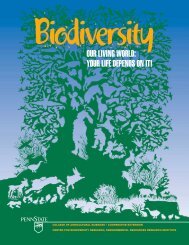Valuation of Biodiversity Benefits (OECD)
Valuation of Biodiversity Benefits (OECD)
Valuation of Biodiversity Benefits (OECD)
- No tags were found...
You also want an ePaper? Increase the reach of your titles
YUMPU automatically turns print PDFs into web optimized ePapers that Google loves.
Conjoint analysisKahn et al. (Chapter 6) discusses the reasons why environmental economics has experiencedlimited success in measuring the value <strong>of</strong> biodiversity and suggest an alternative method, conjointanalysis, which performs an indexing function rather than a monetary valuation function. However,they show how conjoint analysis could be extended to include monetary valuations.The authors also discuss other attempts to create an operational indicator <strong>of</strong> environmentalquality, for example, representative environmental variables, green GDP, satellite accounts used by theUnited Nations Statistical Division, and aggregate indices such as the United States EnvironmentProtection Agency’s Environmental Monitoring and Assessment Program. Their own indicator is achoice, or trade-<strong>of</strong>f based indicator developed using discrete choice based conjoint analysis to presentalternative states <strong>of</strong> the environment to the individual. The alternative states would be defined bydifferent levels <strong>of</strong> physical characteristics <strong>of</strong> the environment, including characteristics <strong>of</strong> importantsub-systems <strong>of</strong> the environment. These alternative states <strong>of</strong> the environment would then comprisechoice sets, and both experts and stakeholders would be asked to choose their preferred set. Theyargue that citizens are used to making such decisions, for example between living in the suburbs or inthe city, marrying or staying single. This method is based on individuals willingness to maketrade-<strong>of</strong>fs. In this way, although no monetary values are elicited, this approach does in Dixon andPagiola’s words “illuminate the trade-<strong>of</strong>fs inherent in biodiversity conservation decisions.”The key to developing the trade-<strong>of</strong>f-weighted index is to appropriately specify choice setsthat provide the survey data used to estimate the preference function. <strong>Biodiversity</strong> could be included asa component <strong>of</strong> overall environmental quality. In this way changes in biodiversity can be measured asthe impact <strong>of</strong> the change in these biodiversity characteristics on the environmental index. Analternative approach would be to develop a set <strong>of</strong> choice sets describing alternative states <strong>of</strong> the world,where only biodiversity characteristics change between choice sets. A difficulty with this alternative isthat citizens may not have the prerequisite knowledge to evaluate such choice sets. A third approach isto include biodiversity and other variables associated with the quality <strong>of</strong> life in different choice sets.Finally a price associated with the environmental or biodiversity resources could be included in thechoice set, in order to assign some value to a change in the level <strong>of</strong> biodiversity. In this approachconjoint analysis based methods can be used to derive monetary estimates <strong>of</strong> the value <strong>of</strong> biodiversity.Kahn et al. describes the development <strong>of</strong> this index approach in measuring the importance <strong>of</strong>biodiversity resources in the Clinch River, United States. Respondents are asked to choose a choice set<strong>of</strong> policy outcomes as indicated in table 1.3. An example <strong>of</strong> such a choice set is provided below.Question: Which option for the future <strong>of</strong> the environment in the Clinch Valley do youprefer the most, Option A, Option B, or Option C? Option C is the status quo, or what is currentlyhappening and will continue to happen with no further environmental policy. Evaluation <strong>of</strong> the resultsprovides information on the preferences <strong>of</strong> citizens for various management/policy options.21












